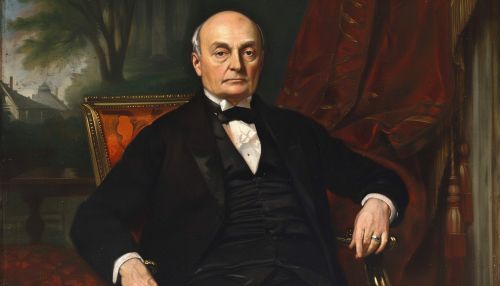John Quincy Adams
Early Life and Education
John Quincy Adams was born on July 11, 1767, in Braintree, Massachusetts, which is now part of Quincy. He was the eldest son of John Adams, the second President of the United States, and Abigail Adams. His early education was conducted by his mother and private tutors. In 1778, he traveled to Europe with his father, who was on a diplomatic mission. This exposure to international politics and cultures profoundly influenced his future career.
Adams attended several schools in Europe, including the University of Leiden in the Netherlands. Upon returning to the United States, he enrolled at Harvard College, where he graduated in 1787. He then studied law under Theophilus Parsons in Newburyport, Massachusetts, and was admitted to the bar in 1790.
Early Career
Adams began his career as a lawyer in Boston but soon transitioned to diplomacy and politics. In 1794, President George Washington appointed him as the U.S. Minister to the Netherlands. His diplomatic skills were further recognized when he was appointed as the U.S. Minister to Prussia in 1797 by his father, President John Adams.
During his time in Europe, Adams negotiated several important treaties, including the Treaty of Mortefontaine with France in 1800. He returned to the United States in 1801 and was elected to the Massachusetts State Senate in 1802.
Diplomatic Achievements
Adams's diplomatic career reached new heights when President James Madison appointed him as the U.S. Minister to Russia in 1809. His tenure in Russia was marked by his efforts to strengthen U.S.-Russian relations during the Napoleonic Wars. He played a crucial role in negotiating the Treaty of Ghent, which ended the War of 1812.
In 1817, President James Monroe appointed Adams as Secretary of State. During his tenure, he was instrumental in formulating the Monroe Doctrine, a cornerstone of American foreign policy that opposed European colonialism in the Americas. Adams also negotiated the Adams-Onís Treaty with Spain in 1819, which ceded Florida to the United States and defined the boundary between the U.S. and New Spain.
Presidency (1825-1829)
John Quincy Adams was elected as the sixth President of the United States in 1824, in a highly contentious election that was decided by the House of Representatives. His presidency was marked by his ambitious vision for national development, which included proposals for a national university, a network of roads and canals, and the promotion of scientific research. However, his administration faced significant opposition from Congress, which was dominated by his political rivals.
Despite these challenges, Adams managed to achieve several important accomplishments. He supported the Tariff of 1828, which protected American industries from foreign competition, and he advocated for the rights of Native Americans, opposing the Indian Removal Act.
Post-Presidency and Congressional Career
After losing the 1828 election to Andrew Jackson, Adams retired to Massachusetts but soon returned to public service. In 1830, he was elected to the House of Representatives, where he served for 17 years until his death. As a congressman, Adams became a leading advocate for the abolition of slavery and a defender of civil liberties. He played a key role in the Amistad case, arguing before the Supreme Court for the freedom of African captives who had revolted on the Spanish ship Amistad.
Adams also opposed the gag rule, which prevented the discussion of anti-slavery petitions in Congress. His persistent efforts led to the eventual repeal of the gag rule in 1844.
Personal Life
John Quincy Adams married Louisa Catherine Johnson in 1797. Louisa was the daughter of an American merchant and a British mother, making her the only First Lady born outside the United States. The couple had four children: George Washington Adams, John Adams II, Charles Francis Adams, and Louisa Catherine Adams.
Adams was known for his intellectual pursuits and was an avid diarist, keeping a detailed journal throughout his life. His writings provide valuable insights into the political and social issues of his time.
Death and Legacy
John Quincy Adams suffered a stroke on February 21, 1848, while on the floor of the House of Representatives. He died two days later in the Speaker's Room of the Capitol Building. He was buried in the family crypt at the United First Parish Church in Quincy, Massachusetts.
Adams's legacy is multifaceted. He is remembered as a skilled diplomat, a visionary president, and a tireless advocate for human rights. His contributions to American foreign policy and his efforts to combat slavery have left a lasting impact on the nation.


